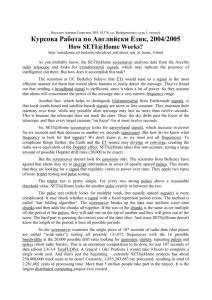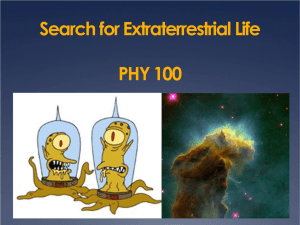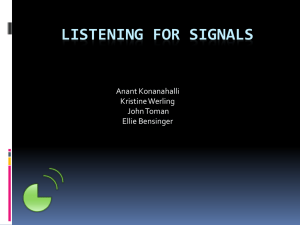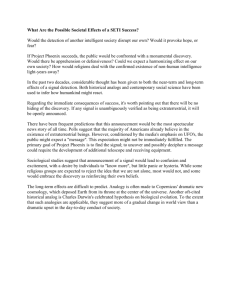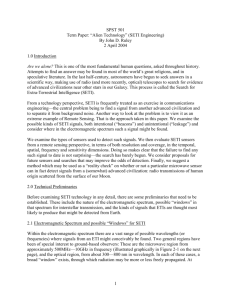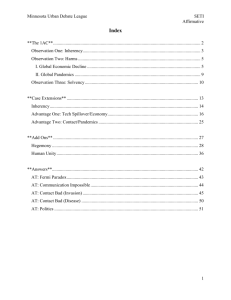Are_Transmissions_to_Space_Dangerous_4_2012
advertisement
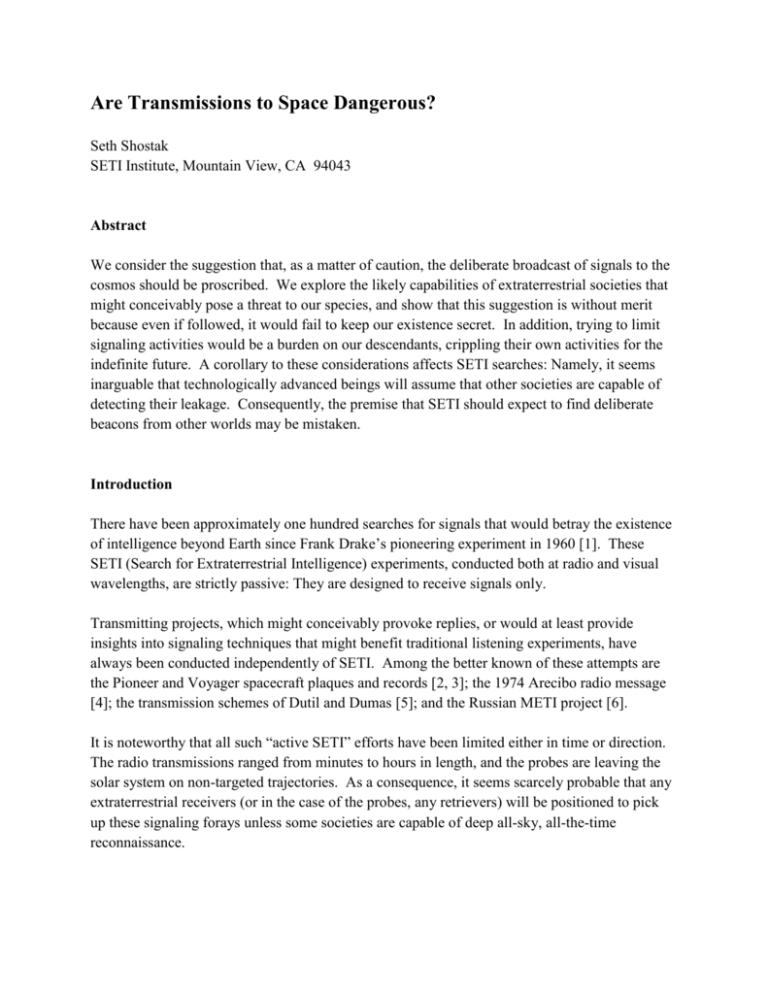
Are Transmissions to Space Dangerous? Seth Shostak SETI Institute, Mountain View, CA 94043 Abstract We consider the suggestion that, as a matter of caution, the deliberate broadcast of signals to the cosmos should be proscribed. We explore the likely capabilities of extraterrestrial societies that might conceivably pose a threat to our species, and show that this suggestion is without merit because even if followed, it would fail to keep our existence secret. In addition, trying to limit signaling activities would be a burden on our descendants, crippling their own activities for the indefinite future. A corollary to these considerations affects SETI searches: Namely, it seems inarguable that technologically advanced beings will assume that other societies are capable of detecting their leakage. Consequently, the premise that SETI should expect to find deliberate beacons from other worlds may be mistaken. Introduction There have been approximately one hundred searches for signals that would betray the existence of intelligence beyond Earth since Frank Drake’s pioneering experiment in 1960 [1]. These SETI (Search for Extraterrestrial Intelligence) experiments, conducted both at radio and visual wavelengths, are strictly passive: They are designed to receive signals only. Transmitting projects, which might conceivably provoke replies, or would at least provide insights into signaling techniques that might benefit traditional listening experiments, have always been conducted independently of SETI. Among the better known of these attempts are the Pioneer and Voyager spacecraft plaques and records [2, 3]; the 1974 Arecibo radio message [4]; the transmission schemes of Dutil and Dumas [5]; and the Russian METI project [6]. It is noteworthy that all such “active SETI” efforts have been limited either in time or direction. The radio transmissions ranged from minutes to hours in length, and the probes are leaving the solar system on non-targeted trajectories. As a consequence, it seems scarcely probable that any extraterrestrial receivers (or in the case of the probes, any retrievers) will be positioned to pick up these signaling forays unless some societies are capable of deep all-sky, all-the-time reconnaissance. In the case of electromagnetic signaling, it is generally assumed that active SETI projects must be of long duration (thousands of years) to offer even the slightest hope for success. Limited financial resources, not to mention the formidable challenge of mounting an experiment spanning many generations, has restricted our transmissions to these sorts of demonstration projects. In addition, active SETI (as such deliberate signaling is called) – even if successful in stimulating a response – is unlikely to do so soon. Estimates of N, the number of technologically accomplished societies in the Galaxy, span the range of 104 – 106 [7]. These numbers imply that even the nearest other society is still 102 – 103 light-years distant, and while these values for N are no more than considered guesses, the minimum distance is largely insensitive to its value, varying as N-1/3. Unlike passive SETI, any response to an active transmission will be a long time in coming, a matter of some discouragement to those eager to prove we’re not alone. Despite these limitations, active SETI continues to be a subject of interest, and is vigorously advocated by some. This advocacy has led to resistance from those who think that transmissions could be dangerous. The argument against deliberate signaling The active SETI efforts to date have not engendered noticeable protest, undoubtedly because of their clearly limited scope. No extraterrestrial beings – friendly or otherwise – are ever likely to retrieve a Voyager probe, an object no larger than a dumpster, sailing silently through dark space. The radio transmissions mentioned above are also widely perceived to be inconsequential, given their limited length and target direction. But deliberately produced transmissions, either in response to a detected signal or as a de novo provocation, are perceived as being more likely to be found by extraterrestrials. Could such emissions expose our planet to invasion or harm? There is a popular perception that advanced intelligence, at a technical level able to find such signals, would have evolved beyond aggression. But these sentiments are no more than opinion, and even if generally true, do not ensure that any signals we send won’t reach a malevolent recipient. The probability of inciting catastrophe might be small, but the consequences could be so severe that some people argue that risky behavior (i.e., deliberate transmissions) should be proscribed [8]. Brin has strenuously suggested that the (passive) SETI community should wield its influence to discourage active transmissions. The physicist Stephen Hawking has also weighed in on the potential threat of active SETI, noting that “If aliens visit us, the outcome would be much as when Columbus landed in America, which didn't turn out well for the Native Americans” [9]. However, we wish to argue that such well-meaning warnings are both pointless and harmful. The Danger Early radio broadcasts, such as commercial AM radio broadcasts initiated in the 1920s, were at frequencies (< 1 MHz) that are reflected by the ionosphere (this generally occurs for all frequencies below ~10 MHz). However, since the Second World War, there has been a growing use of high-frequency, high-power broadcast and radar transmissions. These are signals that sail cleanly into space, and given their ubiquity, radiate in every direction. The exception to the latter are the radars, which are much more directional than television and FM radio broadcasts. As noted, the principal objection to active SETI is that it would produce substantially more visible evidence of our presence than this leakage. And since technologies such as direct satellite broadcast and cable distribution are reducing terrestrial leakage, this disparity between a deliberate signal and leakage will grow. Consequently, the argument that leakage is tolerable while deliberate transmissions are not may seem to have merit. A typical TV broadcaster might sport a transmitter power of 100 kilowatts which, for traditional analog broadcasts, includes a narrow-band carrier of approximately onefifth this total power. Assuming that the antenna has only modest gain (a desideratum in broadcast) of, say, 12 dB, the flux of the carrier at 4 light-years would be 10-29 watts/m2. The LOFAR radio telescope, which is capable of tuning to television frequencies (~100 – 200 MHz), has a predicted maximum sensitivity to a 1 Hz signal of ~2 10-27 watts/m2 after one hour of integration. In other words, LOFAR could not detect the equivalent of our analog TV even at the modest distance of Alpha Centauri. Digital broadcast television also has carriers components in its signals, but these are several factors of two less energetic. Such calculations support the idea that our leakage – at least as represented by broadcast television – is weak, and therefore unable to alert hostile societies of our presence. However, radars are much more visible. Radars used for missile defense can have powers of 5 105 watts, and gains of 25 dB or more. The Arecibo ionospheric radar has a power of 106 watts, and 70 dB of gain, which means that it would be detectable at hundreds of light-years, assuming a receiving setup comparable to our best SETI experiments. Of course, the amount of sky irradiated by Arecibo is miniscule. But there are many hundreds of radar transmitters with peak effective isotropic radiated power exceeding 109 watts, well within the detection limits of our own SETI receivers at tens of light-years. The sky coverage at any given instant for these more intense emitters is typically only a few percent, in the aggregate [10]. But as the Earth rotates, they sweep large areas of the sky. In addition, unlike broadcast television, radar transmissions are not declining on Earth, suggesting that they have indefinite utility (e.g., for determining the orbits of long-period comets.) In summary, while it is argued that terrestrial leakage would not be detectable to putative extraterrestrials, this argument (1) assumes that their receiver capability is no better than the best of our own, and (2) ignores radar, which would be detectable. This already weakens the argument that “our leakage is safe, but we need to forestall deliberate transmissions.” Their capabilities It is obviously true that we have no information on the detection technologies that extraterrestrials might have at their disposal. However, the plea against active SETI is rooted in the assumption that these putative aliens are at a level that would allow them to inflict harm on our descendants, even from a distance of many light-years. This implies that they are at least centuries beyond our own level. After all, while we might be able to mount small interstellar probes to the nearest stars within a century as proposed by the 100-year starship project [11], our ability to wreak havoc on worlds that are dozens or hundreds of light-years distant is clearly inconsequential. In other words, interstellar villains must be centuries beyond us. This statement remains plausible even if their weaponry does not rely on rocketry, but consists of, say, highly focused lasers. Despite many decades of development, military “ray guns” are not yet practical for use in terrestrial combat. The technology for use of such weapons at lightyears distance is, once again, many centuries beyond our capabilities. The fact that any dangerous extraterrestrial society would need be this advanced allows us to make reasonable speculations on their ability to learn of our presence, even in the absence of a deliberate transmission in their direction. Consider an extrapolation of our own technical development into a future centuries beyond where we are now. Our first radio telescopes were constructed in the 1930s. There have been two orders-of-magnitude growth in aperture area per century since [Figure 1] (There has been a similar, rapid growth for the largest optical telescopes). If this pace is maintained, then our own receiver technology would be able to detect even television-level leakage from 500 light-years in ~300 years. Consequently, it seems plausible that any society even modestly beyond our own will be able to detect our radio leakage. And as already noted, they would have adequate sensitivity to find many of our radars even without this degree of technical advantage. Even aside from predictable improvements in ground-based instrumentation, there is another method that advanced societies could use to study the cosmos: gravitational lens telescopes. These take advantage of the focusing effects on electromagnetic radiation by the Sun, as predicted by General Relativity. To use the Sun as a lens requires placing detectors at a distance >550 AU [12], but this is a project that could be undertaken by any society only slightly more advanced than ours. The additional gain provided by a solar lens would be ~105 at meter wavelengths, and would scale proportionally to the mass of the star and inversely proportional to the wavelength of the radiation [13,14]. As example, imagine a radio telescope with a 100 meter aperture and situated at sufficient distance from its home star that the latter functions as a gravitational lens. In one hour of observation, such an instrument could pick up a narrow-band 21 cm, non-directional radio signal of 100 MW at a distance of 500 light-years. If the signal were even modestly beamed in the direction of the receiver – say with a 10 meter antenna – the transmission could be detectable even at a power level of 3 KW, or less than most commercial radio transmitters. There are other signals that are amenable to discovery by such a telescope. Consider a city the size of New York, which has 3 105 streetlamps, each putting out approximately 5 103 lumens or 50 watts in a narrow part of the visible spectrum. If 10 percent of the light is sent skyward, then ~4 1024 photons/sec are radiated into a hemisphere. At 500 light-years, this would produce a detectable signal after one hour of integration, using a 1-meter mirror and the gravitational lensing effect of a solar-type star. Note that, even if the city itself isn’t imaged, the street lamps’ unusual spectral distribution would give away the technological origins of this light. In other words, even our cities are producing detectable leakage. Note that we could, in principle, build such a gravitational lens telescope today, if it were a priority. Any civilization that’s sufficiently advanced to master interstellar travel can be assumed to have such capabilities. Implications for SETI There is a corollary to these arguments that bears on traditional (passive) SETI experiments. If any society a few centuries beyond the invention of radio is able to detect the leakage radiation of other technological societies, then there might be little incentive to make deliberate transmissions for the benefit of inhabitants in other star systems. In other words, the sorts of “beacons” now considered likely prospects for our SETI searches may not, in fact, be considered a useful sort of transmission mode for most societies. The hope for SETI lies in our increasing ability to find leakage, in this view. The above argument against deliberate, alien transmissions would lose its force if a society decreases its leakage faster than it increases its sensitivity to pick up signals. Historic precedent on Earth suggests that, while leakage in some areas is decreasing (e.g., broadcast television), there does not seem to be a similar decrease in radars, street lighting, or other activities that could signal our presence. Conclusion We have shown that any extraterrestrial society at a level to pose a threat to us can find the terrestrial leakage of today and yesterday. Some of our radars are already detectable, but with the type of apertures easily foreseen for a technical culture only a few centuries beyond ours, a wide range of human activities can be found. The use of gravitational lensing would only strengthen this claim. We have already sent signals into space that will alert the aliens to our presence with the transmissions and street lighting of the last 70 years. These emissions cannot be recalled. This suggests that proscriptions on deliberate transmissions in the future will not keep our existence secret. In addition, any such curtailment of our activities must not only encompass any future technologies that might send leakage into space (e.g., solar power satellites), but must be enforced forever. This is an insufferable burden on our descendants. Active SETI may be a worthwhile exercise – either now or later. The objections are obvious: We are still a young technology; there’s little funding; and the elapsed time before any response could be centuries or more. But arguments that it’s dangerous are disingenuous. To forbid deliberate transmissions to the sky is not only an ineffective defensive policy, it is also clearly too late. Worse, such paranoid actions would cripple the activities of every succeeding generation of humanity. It is a certain harm that greatly outweighs its questionable benefit. REFERENCES [1] Drake, F. D. 1961, “Project Ozma,” Phys. Today, 14, 40 [2] Sagan, Carl, Salzman Sagan, Linda, and Drake, Frank 1972, “A Message from Earth,” Science 175, 881 [3] Eberhart, Jonathan 1977, “The World on a Record,” Science News, 112, 124 [4] National Astronomy and Ionosphere Center 1975, “The Arecibo message of November 1974,” Icarus, 26, 462 [5] Dutil, Y. and Dumas, S. 1998, “Active SETI: Targets Selection and Message Conception,” presented at American Astronomical Society Meeting 93, No. 97.10 [6] Zaitsev, A. L. and Ignatov, S. P. 1999, “Broadcast for extraterrestrial intelligence from Evpatoria Deep Space Center,” http://www.matessa.org/~mike/2001.html [7] Dick, S. J. 1996, The Biological Universe, Cambridge University Press (Cambridge) [8] Brin, D. 2006, “Shouting at the Cosmos,” http://www.davidbrin.com/shouldsetitransmit.html [9] Sheridan, Michael 2010, “Stephen Hawking on ‘Into the Universe with Stephen Hawking’: Contact with aliens could get us killed,” New York Daily News, April 25 [10] Ekers, R. D., Cullers, D.K., Billingham, J., and Scheffer, L. K. eds. 2002, SETI 2020: A Roadmap for the Search for Extraterrestrial Intelligence, SETI Press, (Mountain View) [11] See http://100yss.org/ [12] Drake, Frank 1987 “Stars as Gravitational Lenses,” Bioastronomy – The Next Steps, G. Marx ed., Kluwer (Dordrecht) p. 391 [13] Eshleman, V. R. 1979, Science, 205, 1133 [14] Eshleman, V. R. 1984, Sky & Telescope, June, p. 493 Figure 1: Aperture area of the largest radio telescopes as function of time. The line is a leastsquares fit to these data.

